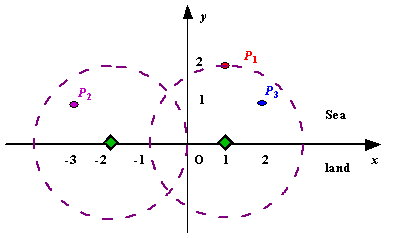Description
Assume the coasting is an infinite straight line. Land is in one side of coasting, sea in the other. Each small island is a point locating in the sea side. And any radar installation, locating on the coasting, can only cover d distance, so an island in the sea can be covered by a radius installation, if the distance between them is at most d.
We use Cartesian coordinate system, defining the coasting is the x-axis. The sea side is above x-axis, and the land side below. Given the position of each island in the sea, and given the distance of the coverage of the radar installation, your task is to write a program to find the minimal number of radar installations to cover all the islands. Note that the position of an island is represented by its x-y coordinates.

Figure A Sample Input of Radar Installations
We use Cartesian coordinate system, defining the coasting is the x-axis. The sea side is above x-axis, and the land side below. Given the position of each island in the sea, and given the distance of the coverage of the radar installation, your task is to write a program to find the minimal number of radar installations to cover all the islands. Note that the position of an island is represented by its x-y coordinates.

Figure A Sample Input of Radar Installations
Input
The input consists of several test cases. The first line of each case contains two integers n (1<=n<=1000) and d, where n is the number of islands in the sea and d is the distance of coverage of the radar installation. This is followed by n lines each containing two integers representing the coordinate of the position of each island. Then a blank line follows to separate the cases.
The input is terminated by a line containing pair of zeros
The input is terminated by a line containing pair of zeros
Output
For each test case output one line consisting of the test case number followed by the minimal number of radar installations needed. "-1" installation means no solution for that case.
Sample Input
3 2 1 2 -3 1 2 1 1 2 0 2 0 0
Sample Output
Case 1: 2 Case 2: 1
Source
这道题就是一道贪心题,思路并不难,但是悲催的是WA了5次,居然是因为如果不符合条件时输出-1时直接输出了-1,前面没带Case。。。。sad。。。害得我把点的排序按点排了一次,又按区间左端点排了一次。。不过事后发现这两种排序都可以。。
本题贪心思路是把点转化为在x轴坐标上的区间(即能保证覆盖该小岛的雷达所有可能位置的集合),然后按点的顺序排也行,按左端点排也行。然后最左边的依次向右遍历,如果下一个区间的最左端在上一个雷达的右端,显然需要放一个新雷达;如果在左端的话,则需要判断最右端了,如果最右端也在上个雷达左端的话,那么这个雷达显然不能覆盖当前这个小岛,需要把雷达位置调整为当前区间的最右端,这样既能覆盖之前的也能覆盖现在的;如果最右端在上个雷达右端,则无需调整也无需放置新雷达。
#include <stdio.h>
#include <stdlib.h>
#include <string.h>
#include <math.h>
#include <algorithm>
using namespace std;
struct node
{
double zuo, you;
} fei[2100], t;
int cmp(node a, node b)
{
return a.zuo < b.zuo;
}
int x[2100],y[2100];
int main()
{
int i, j, n, d, num, flag, s=0;
double z, p;
while(scanf("%d%d",&n,&d)!=EOF)
{
if(n==0&&d==0) break;
s++;
flag=0;
for(i=0; i<n; i++)
{
scanf("%d%d",&x[i],&y[i]);
if(y[i]>d)
flag=1;
}
if(flag)
printf("Case %d: -1\n",s);
else
{
for(i=0; i<n; i++)
{
z=sqrt(d*d*1.0-y[i]*y[i]*1.0);
fei[i].zuo=(double)x[i]-z;
fei[i].you=(double)x[i]+z;
}
sort(fei,fei+n,cmp);
num=0;
p=-100000000;
for(i=0; i<n; i++)
{
if(fei[i].zuo>p)
{
num++;
p=fei[i].you;
}
else if(fei[i].you<p)
{
p=fei[i].you;
}
}
printf("Case %d: %d\n",s,num);
}
}
return 0;
}






















 457
457

 被折叠的 条评论
为什么被折叠?
被折叠的 条评论
为什么被折叠?








